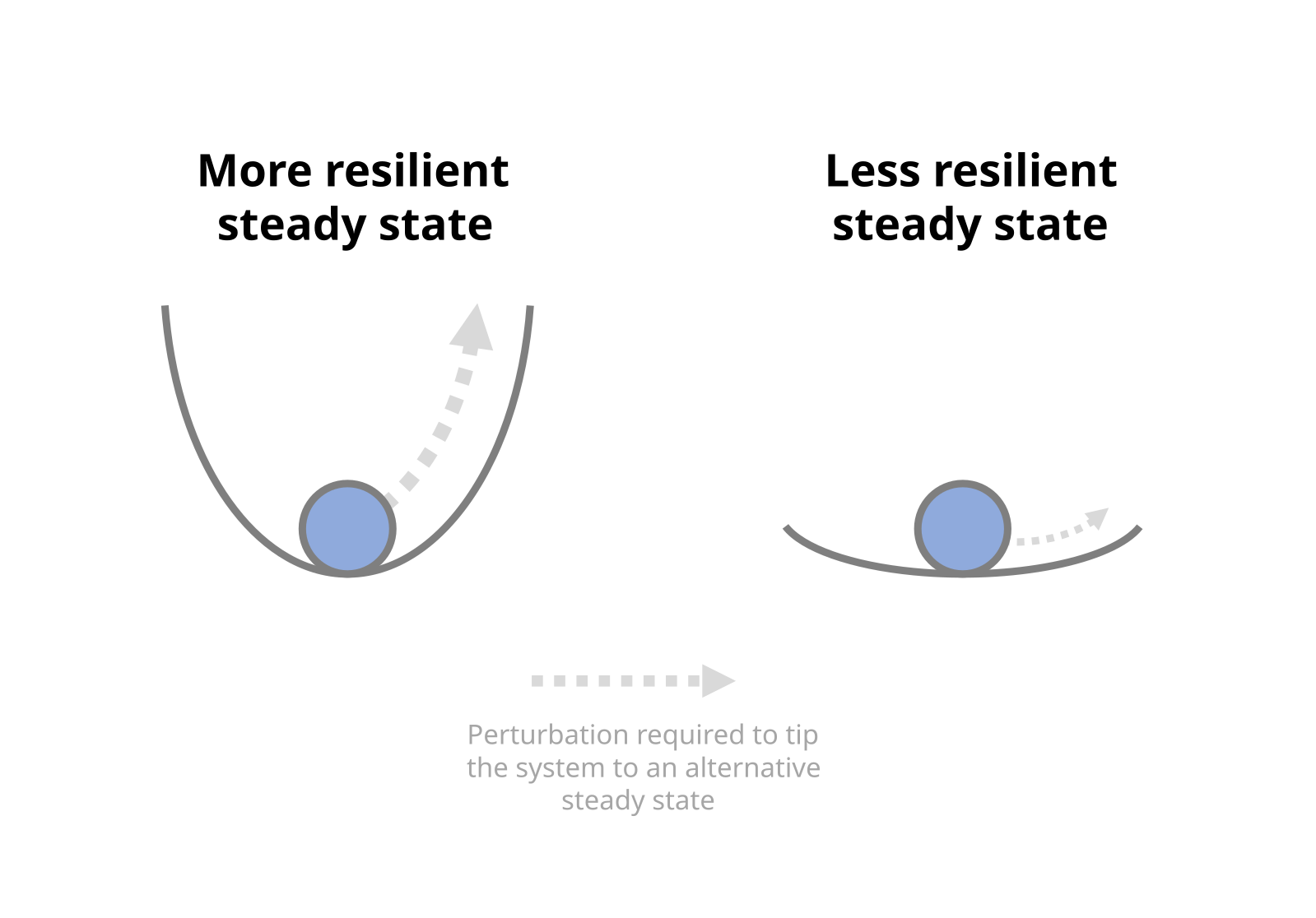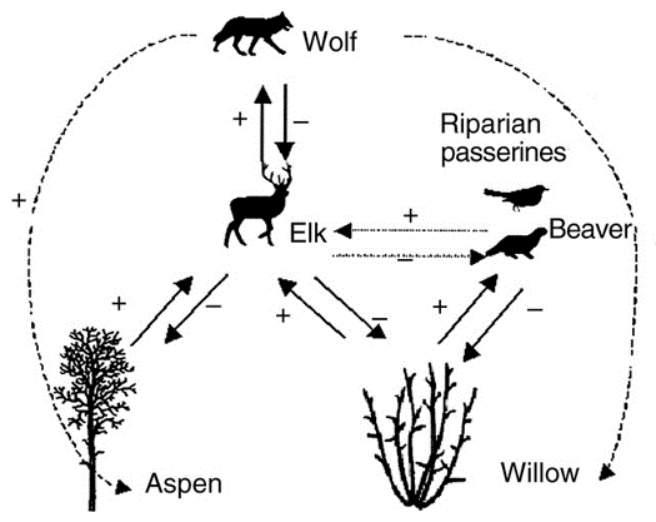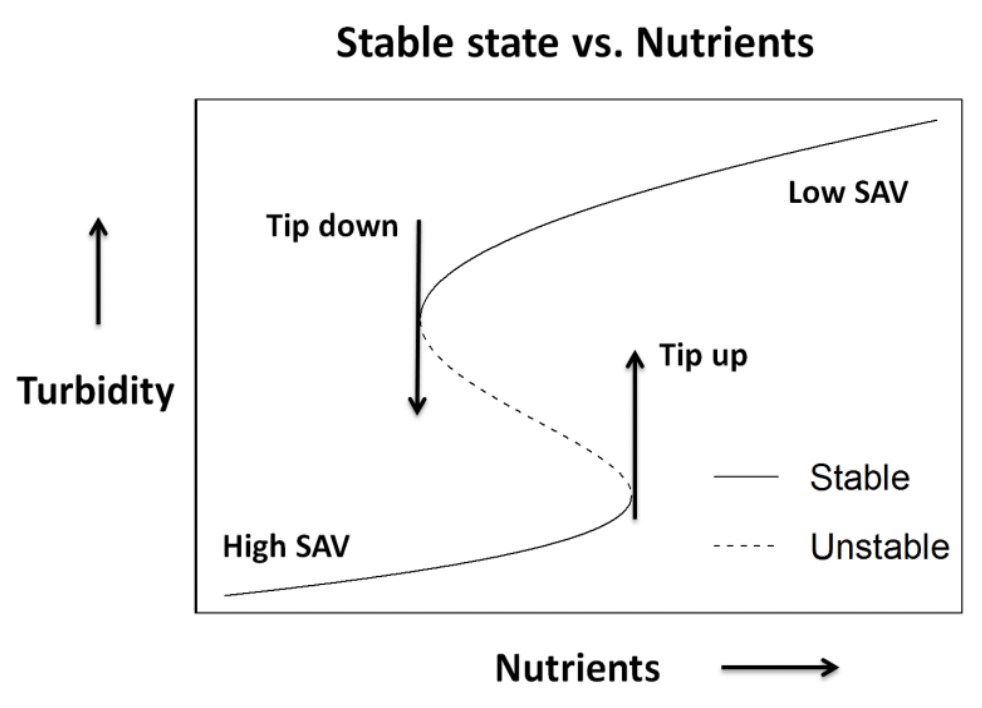IB Syllabus focus:
‘The climax concept is contested; alternative stable states can arise from stochastic events or herbivore/top-down effects.’
Climax communities have long been seen as the stable endpoint of ecological succession, but modern ecology recognises variability, disturbances, and alternative stable states that challenge this view.

Ball-and-valley “stability landscape” showing a system in one of multiple basins of attraction. A deeper valley indicates greater resilience, meaning stronger perturbations are needed to shift state. This general conceptual diagram underpins debates about climax and regime shifts in ecosystems. Source.
The Classical Climax Concept
Origins of the Idea
The climax community was historically defined as the final, stable stage of ecological succession in which ecosystems reach equilibrium with their environment. This view, associated with Frederic Clements in the early 20th century, treated ecosystems as if they developed in a predictable, directional sequence towards one stable endpoint.
Limitations of the Classical Model
This model assumed:
Determinism: Succession followed a fixed trajectory.
Equilibrium: Ecosystems would stabilise permanently in one climax state.
Uniformity: Similar climates would always yield similar climax communities.
Such assumptions neglect the role of disturbance, species diversity, and random events.
Debates Around Climax
Multiple Climax Hypothesis
Arthur Tansley and later ecologists argued that climax is not singular but varies with:
Soil conditions (edaphic climax).
Fire regimes (fire climax).
Human activity (anthropogenic climax).
This perspective recognises that many factors influence long-term ecosystem stability, not only climate.
Dynamic Nature of Ecosystems
Modern ecology views ecosystems as non-equilibrium systems, constantly shaped by disturbance, migration, and resource fluctuation. Instead of a fixed endpoint, ecosystems may remain in flux while maintaining functional integrity.
Alternative Stable States
Concept Overview
An alternative stable state is when an ecosystem can exist in more than one relatively stable configuration under the same external conditions.
Alternative Stable State: A condition in which ecosystems have multiple possible long-term equilibria, with transitions triggered by disturbances or changes in internal dynamics.
Ecosystems may shift abruptly between states if thresholds or tipping points are crossed.
Mechanisms Leading to Alternative States
Stochastic events: Random occurrences such as storms, floods, or disease outbreaks alter species composition.
Top-down effects: Changes in predator populations reshape community structure.
Bottom-up effects: Variations in nutrients or resources alter productivity and competition.
Once established, feedback loops reinforce the new state, making reversal difficult without major intervention.

Simplified trophic cascade where wolves reduce elk browsing, allowing riparian vegetation to recover. Such predator-mediated changes can stabilise different community configurations under similar external conditions. The diagram complements the syllabus emphasis on top-down effects in alternative stable states. Source.
Case Studies in Alternative Stable States
Coral Reefs
Healthy reefs dominated by hard corals can shift to algal-dominated systems after overfishing or bleaching events.
Recovery is challenging because algae prevent coral larvae from re-establishing.
Grasslands vs Forests
Fire frequency influences whether an area supports woody vegetation or remains grassland.
Both can be stable under the same climate but depend on disturbance regimes.
Lakes and Eutrophication
Clear-water lakes with aquatic plants can shift to turbid, algae-dominated states after nutrient loading.
Feedback mechanisms, like reduced light penetration, lock in the new state.

Bifurcation diagram for shallow lakes showing two stable states (clear with high SAV vs turbid with low SAV) separated by an unstable state and distinct tipping points (“tip up” and “tip down”). This is a canonical ecological example of alternative stable states and hysteresis. The figure is directly relevant; no extra detail beyond what the syllabus requires is included. Source.
Role of Herbivores and Predators
Herbivory in Shaping Communities
Large herbivores, such as deer or elephants, exert top-down control by:
Preventing forest regeneration through grazing.
Maintaining open grassland habitats.
Their presence or absence may push ecosystems into alternative states.
Predator Regulation
Predators can stabilise ecosystems by controlling herbivore populations.
Wolf reintroduction in Yellowstone shifted the park from overgrazed valleys to reforestation.
Predator loss often reduces resilience and increases the likelihood of shifts.
Human Influence in Climax Debates
Anthropogenic Effects
Humans alter succession and stability through:
Deforestation leading to long-term grassland states.
Fire suppression preventing natural cycles and producing novel successional pathways.
Agricultural systems creating permanent plagioclimaxes.
Feedback Loops and Thresholds
Human impacts may reduce resilience, making ecosystems more vulnerable to irreversible regime shifts. Once altered, restoring the original state may require substantial intervention.
Implications for Ecosystem Management
Recognising Non-Equilibrium Systems
Conservation strategies must account for:
The possibility of multiple stable states.
The difficulty of reversing transitions once thresholds are crossed.
The role of diversity and resilience in preventing undesirable shifts.
Adaptive Management Approaches
Ecologists and policymakers increasingly favour adaptive management, which involves:
Monitoring systems for early warning signs of tipping points.
Maintaining ecological processes rather than aiming for one climax state.
Using controlled disturbance (e.g., fire or grazing) to maintain desired states.
FAQ
A climax community refers to the traditional view of one final, stable stage of succession in balance with climate.
An alternative stable state recognises that under the same climate and external conditions, multiple stable community configurations may exist. This challenges the idea of a single predictable endpoint.
Feedback loops reinforce the conditions of the current state, making it resistant to change.
In a forest, tree cover reduces grass growth, which prevents fires, reinforcing forest dominance.
In a grassland, frequent fires maintain open areas, reducing tree establishment, reinforcing grass dominance.
These loops explain why once an ecosystem shifts, it may remain locked in its new state.
Yes. Human activities alter disturbance regimes and resource flows, producing states that would not exist naturally.
Examples include:
Overgrazed rangelands locked into degraded shrubland.
Agricultural fields maintained as permanent plagioclimaxes.
Such interventions may create long-lasting shifts that persist even if human pressure is reduced.
Resilience describes the capacity of an ecosystem to absorb disturbances and remain in the same state.
An ecosystem with high resilience is less likely to cross a tipping point into a new stable state.
Debates about climax highlight whether ecosystems truly reach long-term equilibrium or whether resilience simply delays inevitable shifts caused by disturbance.
Stochastic events are random and unpredictable, such as storms, fires, or disease outbreaks.
These events can:
Reset successional stages, preventing a single climax from forming.
Push ecosystems across thresholds into new configurations.
Because they are unpredictable, they add uncertainty to whether ecosystems reach a traditional climax or shift into alternative states.
Practice Questions
Question 1 (2 marks)
Define the term alternative stable state in the context of ecological succession.
Mark Scheme:
1 mark for recognising that ecosystems can exist in more than one stable configuration under the same external conditions.
1 mark for including that transitions between states are triggered by disturbances or changes in system dynamics.
Question 2 (5 marks)
Discuss how top-down effects, such as predator regulation, can lead to alternative stable states in ecosystems. Use examples to support your answer.
Mark Scheme:
1 mark for explaining top-down effects as regulation by higher trophic levels (predators/herbivores).
1 mark for describing how predators can control herbivore populations, preventing overgrazing.
1 mark for stating that removal or reintroduction of predators can push ecosystems into different stable states.
1 mark for a relevant example (e.g., wolf reintroduction in Yellowstone or elephants maintaining grasslands).
1 mark for linking the example to the broader concept of alternative stable states (different vegetation structures or community dynamics under the same climate).

